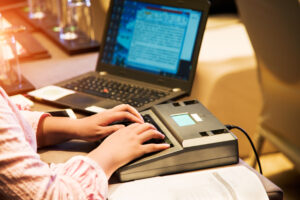Everything You Need to Know About Court Reporting

If you work in the legal field, chances are you will need the support of a court reporter many times in your career. Learn more about court reporting here.
What is a Court Reporter?
Also called “guardians of the record,” court reporters capture the spoken word in real time, creating transcripts of depositions, trials, speeches, and other meetings where a person’s spoken words must be preserved in writing. Court reporters are expected to produce complete, accurate, and unbiased transcripts for the legal record.
In addition, many court reporters assist judges and attorneys by organizing or searching for information in the record. Some also work outside the realm of official courtroom proceedings, capturing the spoken word at sales meetings, press conferences, training seminars, product releases, and televised sporting events.
Methods of Court Reporting
Strategies vary for capturing the spoken word in real time, but they all utilize technology.
Stenography
The most common court reporting method is called stenography. Stenographers use a special piece of equipment known as a stenotype keyboard or steno machine. They press letter keys in certain combinations to represent sounds, words, or phrases. The keystrokes are converted into regular writing and displayed as text on a screen in a process called computer-aided transcription (CAT).
In cases when real-time court reporting is desired, the text appears instantly on a large screen for the judge and others in the courtroom to view. This is particularly useful for ensuring everyone can participate in the legal process, including the deaf and hard of hearing.
After the proceedings have ended, the court reporter goes back and checks for computer-generated grammatical errors, spelling mistakes, and other inaccuracies. The final copy should be complete and error-free.
Electronic Reporting
This method involves recording the proceedings using a tape recorder or digital equipment. A court reporter or transcriber then goes back later and generates a written record of the recording.
Voice Writing
For this method, court reporters wear a voice-silencing mask containing a microphone. They then repeat everything spoken by witnesses, attorneys, judges, and others during a legal proceeding into the microphone. Using computer speech recognition technology, it’s possible for voice writing to provide real-time court reporting. The official written transcript is prepared afterward, either manually or with speech recognition software.
Education and Licensing
California has demanding requirements for court reporters. To qualify for the licensing exam, hopefuls must complete an approved educational program and master the steno machine. Applicants must transcribe at 200 words per minute with 97.5 percent accuracy to pass the skills portion of the exam. Then, they must pass two written tests. After becoming a certified court reporter, continuing education classes are required to keep the license active.
At Talty Court Reporters, we utilize the latest technology to deliver the very best results in your legal case. Turn to us for top-quality court reporting and transcribing services, video and audio conferencing, remote depositions, and much more. For additional information about our services, or to request a cost estimate, please contact us today.
““